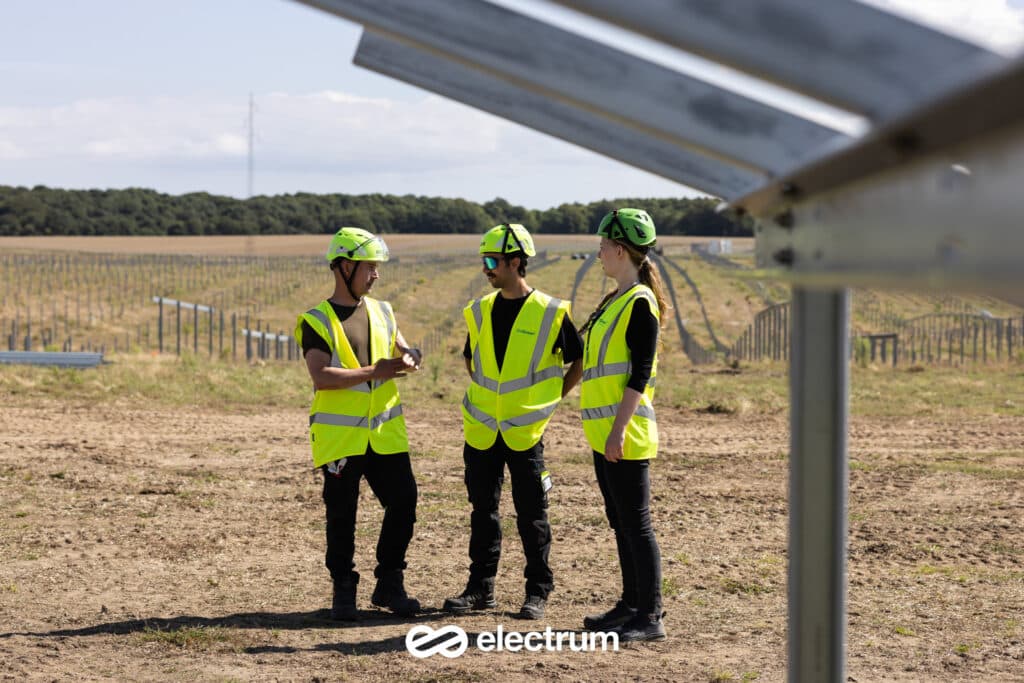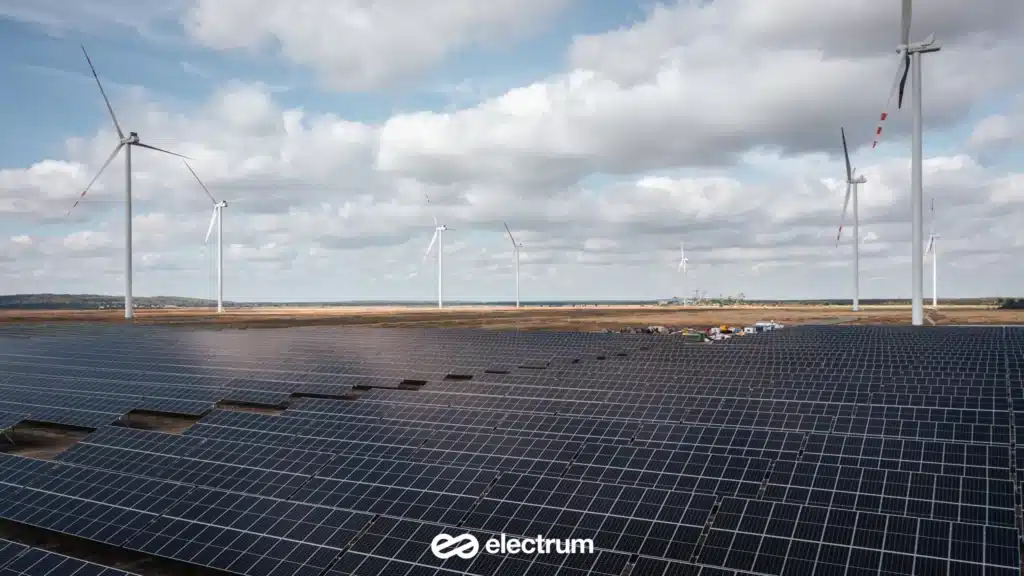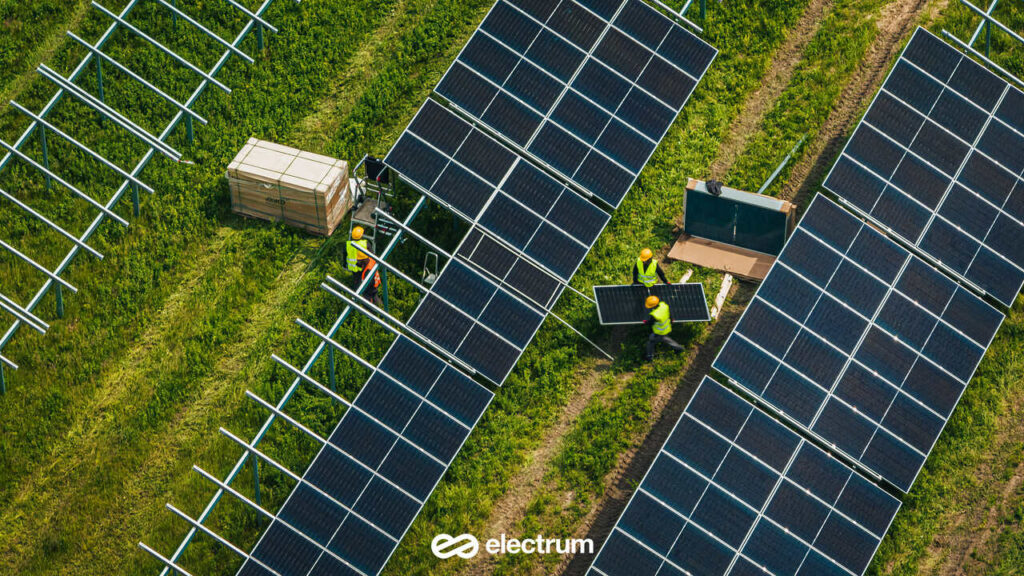Solar farm construction is a unique endeavor that provides society with clean electrical energy and contributes to environmental protection. At the same time, it’s an investment whose profitability continues to grow.
We invite you to watch a video about one of our projects – PV Gryf solar farm:
And one more piece of good news – we will be executing a solar project in Denmark: Electrum to build photovoltaic (PV) project for BeGreen in Denmark

Table of Contents
- PV Panels
- Stages of Photovoltaic Farm Construction
- Step-by-Step Guide to Building a Photovoltaic Farm
- Monitoring and Maintenance of Photovoltaic Farms
- Investment in Photovoltaic Farm Construction
- Renewable Energy EPC Contractors
In Brief
The key stages of building a solar farm include designing, site preparation and foundations, installation of photovoltaic panels, and electrical connections and testing.
In the design phase, important steps include planning the layout of panels and inversion systems, integration with other systems, obtaining permits and complying with regulations, and selecting the solar farm’s location.
Technological advancements in PV panels are increasing the profitability of photovoltaic farms. The construction process of a photovoltaic farm can take anywhere from a few months to several years, depending on the scale of the project, location, weather, and other factors.
The benefits of building photovoltaic farms are immense, both economically and environmentally.

Let’s start by taking a closer look at PV panels.
Photovoltaic panels, also known as PV panels, are the fundamental component of solar farms. They are often one of the highest costs in the investment.
How exactly do they work, and why is the progress in their efficiency so important?
Photovoltaic technology is based on harnessing solar energy to generate electricity. PV panels contain silicon solar cells that convert sunlight into electricity.
Advances in this technology include increased efficiency in converting solar energy into electrical power. New panels are more efficient, allowing for greater energy production from the same amount of sunlight.
Stages of Solar Farm Construction
Solar farm design
The preparation of a solar farm design is a crucial step in the entire project. Planning the layout of panels and inversion systems is essential.
Attention must also be paid to integrating various energy systems within the farm to ensure everything operates smoothly. When creating a solar farm design, it is necessary to consider regulatory and permitting issues.
Read the guide: Solar Power System Design – What You Need to Know?
Location of the Solar Farm
Designing solar farms also requires analyzing the location. The choice of the farm’s location affects the amount of available sunlight and the efficiency of the panels. Therefore, it is essential to thoroughly examine the geographical and climatic conditions to select the optimal site for the farm.
We have extensive design experience and conduct processes to prepare renewable energy facilities for the Ready to Build stage.
Step-by-Step Guide to Building a Photovoltaic Farm

After the design process is completed, we move on to the construction of the photovoltaic farm. This process involves several key steps.
Site Preparation and Foundations
The construction of a photovoltaic farm begins with preparing the site where the PV panels will be installed. It is essential to clear any obstacles and prepare the land for installation. Foundations are crucial as they provide stability to the photovoltaic panels. They must be properly reinforced and adapted to the local conditions.
Installation of Photovoltaic Panels
Next, we proceed with the installation of the photovoltaic panels. The panels are mounted on the foundations in the appropriate layout to maximize the use of available sunlight. The installation process is carefully monitored to ensure the stability and efficiency of the system.

Electrical Connections and Testing
After the panels are installed, the next phase involves electrical connections and testing. The panels are interconnected and connected to the inversion system, which converts direct current (DC) into alternating current (AC), suitable for residential or industrial use. Testing is essential to ensure that the entire system operates correctly.
Monitoring and Maintenance of Solar Farms
Once the construction of the farm is completed, it is crucial to monitor its performance and conduct routine maintenance and servicing.
Monitoring systems enable continuous oversight of the photovoltaic panels’ operation. In case of failures or issues, a quick response is possible. Routine maintenance includes cleaning the panels and checking their technical condition.
Read also: PV panel maintenance: The key to extended life and efficiency
How long does it take to build a solar farm?
The construction time of a solar farm depends on factors such as:
- The scale of the project and the capacity of the photovoltaic farm,
- Location and regulations,
- Weather conditions,
- Chosen technologies and methods,
- Efficiency and experience of the general contractor.
As Electrum Holding, a general contractor for solar farms and other renewable energy facilities, we have completed numerous projects. Below, you’ll find out how long it took to build some of the photovoltaic farms we’ve delivered:
- Przykona Solar Farm – just over a year
- Krzywińskie Solar Farm – approximately 9 months
If you’re looking for a photovoltaic farm contractor with a rich portfolio, get to know us better!
Solar Farm Construction FAQ
1. What are the main benefits of building solar power plants?
The main benefits of building solar power plants include energy cost savings, the production of clean energy, the reduction of greenhouse gas emissions, improvement of air quality, and potential profits from surplus energy that can be sold back to the grid. For investors, this also means a stable source of income.
2. Are solar farms profitable in all regions?
Solar farms can be profitable in many regions, especially where there is abundant sunlight. However, the farm’s efficiency depends on location and climatic conditions. Therefore, a thorough analysis of the site and project is essential before constructing a farm.
3. What are the latest technological innovations in solar panels?
The latest innovations in photovoltaic technology focus on increasing the efficiency of converting solar energy into electricity. New panel technologies allow for more efficient use of sunlight. Additionally, thin photovoltaic layers are being developed, which are more flexible and easier to install.
4. What does it mean to be an EPC contractor for renewable energy projects?
EPC (Engineering, Procurement, and Construction) contractors for renewable energy projects are specialized solar farm construction companies that manage renewable energy projects, including solar, wind power plants, and more. Collaboration with an EPC contractor allows investors to benefit from expertise and professional project management.
5. What challenges might arise during the solar farm construction?
Solar power plant construction can face various challenges, including obtaining the necessary permits and complying with regulations for renewable energy projects. The construction contractor is responsible for executing multiple stages of the project. Coordinating the efforts of multiple teams, procuring materials, meeting delivery deadlines, and maintaining high safety standards are crucial issues. Collaboration with an EPC contractor for renewable energy projects can help effectively manage these challenges.


